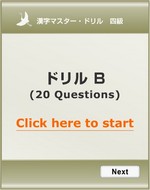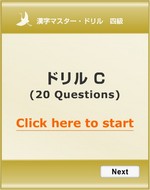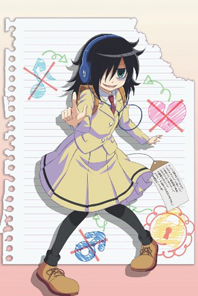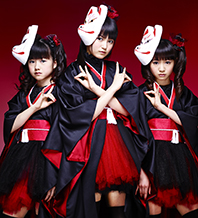Part 2: 一 二 三 四 五 六 七 八 九 十
Read this page briefly and spend most of your time on the drill exercise for quick memorization.
一 : イチ、イツ、ひと、ひと(つ)
Meaning: one Shape: Symbolizing the concept "one" by single line.
|
Click to see the stroke order animation.
| Word | Reading | Meaning | Class |
|---|---|---|---|
| 一 | いち | 1 | n |
| 一つ | ひとつ | 1 (counter for things) | n |
| 一人 | ひとり | 1 person | n |
| 一日 | ついたち | 1st day of the month (date) | n |
| 一日 | いちにち | 1 day (duration) | n |
| 一月 | いちがつ | January (date) | n |
| 一月 | ひとつき | 1 month (duration) | n |
| 一か月 | いっかげつ | 1 month (duration) | n |
| 一[番] | いちばん | first, best, number one | n, adv |
Notes
一日 and 一月 can be used for date and for duration. The reading is different in each case.
一月(ひとつき) and 一か月(いっかげつ) mean the same. ~か月 is used more often.
二 : ニ、ふた、ふた(つ)
|
Meaning: two Shape: Symbolizing the concept "two" by double lines.
|
| 二 | に | 2 | n |
| 二つ | ふたつ | 2 (counter for things) | n |
| 二人 | ふたり | 2 persons | n |
| 二日 | ふつか | 2nd of the month, 2 days | n |
| 二月 | にがつ | February | n |
Notes
二日(ふつか) can be used for date and for duration. The reading is the same. The same rule applies for other numbers except for 一日.
三 : サン、み、みっ(つ)、み(つ)
|
Meaning: three Shape: Symbolizing the concept "three" by triple lines.
|
| 三 | さん | 3 | n |
| 三つ | みっつ | 3 (counter for things) | n |
| 三日 | みっか | 3rd of the month / 3 days | n |
| 三月 | さんがつ | March | n |
Notes
There are two ways of counting numbers 1 to 10.
One is いち, に, さん, よん(し), ご, ろく, なな(しち), はち, きゅう(く), じゅう. This is the standard way, and is commonly used.
Another set is ひとつ, ふたつ, みっつ, よっつ, いつつ, むっつ, ななつ, やっつ, ここのつ, とお. Nowadays, this way is used mostly for counting things. Note that you cannot count more than 10 in this way.
四 : シ、よ、よっ(つ)、よ(つ)、よん
|
Meaning: four
|
| 四 | よん, し | 4 | n |
| There are two ways of reading yon and shi. Yon is used more often. | |||
| 四つ | よっつ | 4 (counter for things) | n |
| 四日 | よっか | 4th of the month / 4 days | n |
| 四月 | しがつ | April | n |
五 : ゴ、いつ、いつ(つ)
|
Meaning: five
|
| 五 | ご | 5 | n |
| 五つ | いつつ | 5 (counter for things) | n |
| 五日 | いつか | 5th of the month / 5 days | n |
| 五月 | ごがつ | May | n |
六 : ロク、む、むい、むっ(つ)、む(つ)
|
Meaning: six
|
| 六 | ろく | 6 | n |
| 六つ | むっつ | 6 (counter for things) | n |
| 六日 | むいか | 6th of the month / 6 days | n |
| 六月 | ろくがつ | June | n |
七 : シチ、なな、なな(つ)、なの
|
Meaning: seven
|
| 七 | なな, しち | 7 | n |
| There are two ways of reading nana and shichi. Nana is used more often. | |||
| 七つ | ななつ | 7 (counter for things) | n |
| 七日 | なのか | 7th of the month / 7 days | n |
| 七月 | しちがつ | July | n |
八 : ハチ、や、やっ(つ)、や(つ)、よう
|
Meaning: eight
|
| 八 | はち | 8 | n |
| 八つ | やっつ | 8 (counter for things) | n |
| 八日 | ようか | 8th of the month / 8 days | n |
| 八月 | はちがつ | August | n |
九 : キュウ、ク、ここの、ここの(つ)
|
Meaning: nine
|
| 九 | きゅう, く | 9 | n |
| There are two ways of reading kyū and ku. Kyū is used more often. | |||
| 九つ | ここのつ | 9 (counter for things) | n |
| 九日 | ここのか | 9th of the month / 9 days | n |
| 九月 | くがつ | September | n |
十 : ジッ、ジュウ、と、とお
|
Meaning: ten
|
| 十 | じゅう | 10 | n |
| 十 | とお | 10 (counter for things) | n |
| 十日 | とおか | 10th of the month / 10 days | n |
| 二十日 | はつか | 20th of the month / 20 days | n |
| 十月 | じゅうがつ | October | n |
| 十一月 | じゅういちがつ | November | n |
| 十二月 | じゅうにがつ | December | n |
Writing Practice
Handwriting practice improves your character recognition ability.
It is recommended to do the writing practice to get familiar with the shape of letters.
Printable writing practice sheet is available at Kanji Writing Practice page.
Structure of Kanji
There are some patterns of structure;
- Left+Right: 明(日+月), 社(ネ+土), 秋(禾+火), 休(人+木)
- Upper+Lower: 分(八+刀), 古(十+口), 名(夕+口), 男(田+力)
- Outside+Inside: 回(口+口), 国(口+玉), 聞(門+耳), 間(門+日)
Kanji symbols are composed of limited number of components.
Some Kanji symbols you have learned are commonly used as a component of other Kanji.
- 人: 作, 位, 夜, 座, 肉, 欠, 貸
- 日: 明, 冒, 間, 星, 早, 音, 温
- 土: 寺, 圧, 去, 走, 考, 経, 都


















